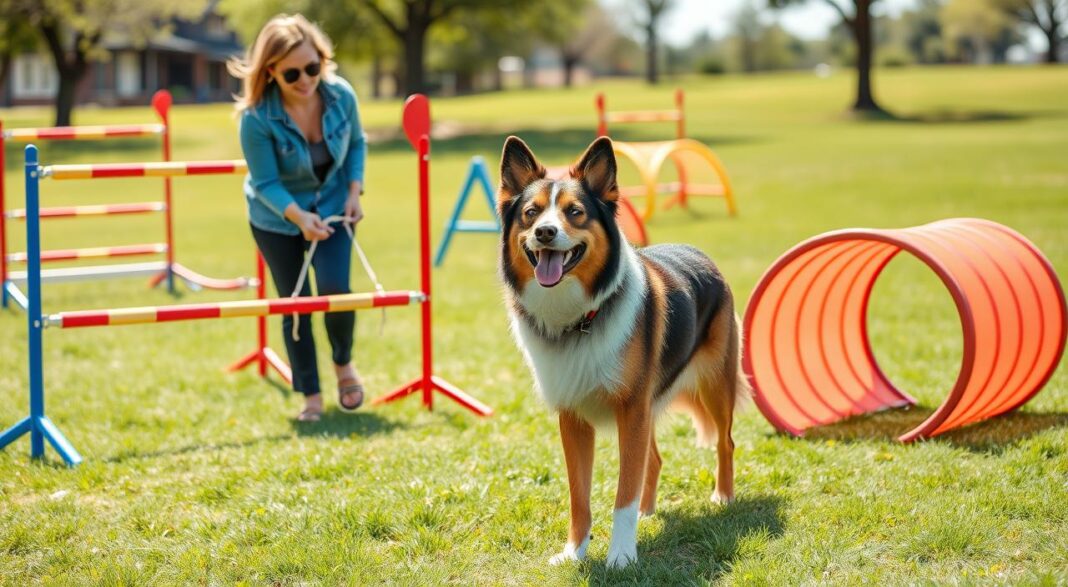The Australian Cattle Dog is strong and smart. They are great companions at work and at home. However, owners may face challenges like reactivity and herding behavior.
Luckily, there are effective solutions for Australian cattle dog behavior issues. These can help dogs and their humans live together happily. Understanding their Australian cattle dog temperament and directing their energy well is essential.
Key Points
- Recognizing and addressing behavior issues early promotes a well-balanced Australian Cattle Dog.
- Providing routine care and monitoring for potential health issues are essential for their well-being.
- Given their high energy and herding instincts, ample exercise and mental stimulation are vital.
- Socialization, proper training, and consistent routines play a crucial role in curbing aggression and overexcitement.
- Understanding the breed’s history and qualities helps tailor the right solutions for individual behavior challenges.
Introduction to Australian Cattle Dog Temperament and Challenges
Australian Cattle Dogs are not just pets. They are bursts of energy, smart, and full of loyalty. Known for their sharp herding skills, these dogs are the top pick for those needing a skilled working dog.
Yet, their strong traits also mean unique behavioral challenges, needing smart and steady training.
Understanding the Energetic Nature of Australian Cattle Dogs
The energy of Australian Cattle Dogs is impressive. Bred for tough jobs, they have a lot of energy. This can become a problem if not handled right.
Australian cattle dog training tips stress the need for plenty of exercise—two hours every day is ideal. This helps use their energy in good ways. Without enough exercise and brain games, they might start acting out or feel very frustrated.
Common Behavior Complaints from Australian Cattle Dog Owners
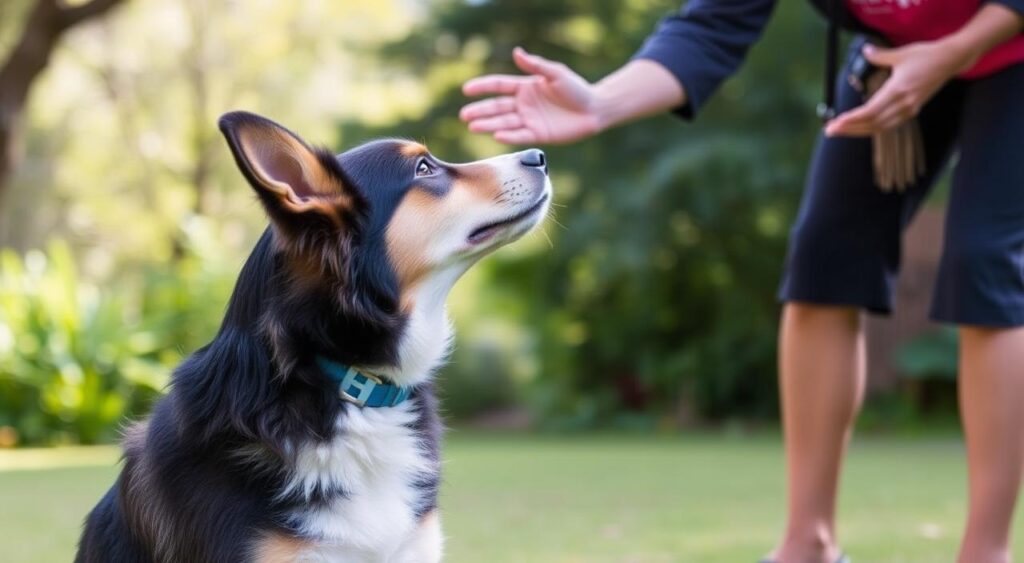
When it comes to dealing with Australian cattle dog behavioral problems, owners often talk about too much barking, chewing, and sometimes aggression towards strangers and other animals.
This comes from the dog’s strong need to protect and their high sensitivity. They love their families but are wary of strangers. This means they need careful and ongoing socializing.
Training that includes mind and body exercises can really help with these behavior issues. This method keeps them fit and sharp, making bad behaviors less likely.
To find out about another breed known for loyalty and protection, consider the Rajapalayam dog.
Understanding and guiding the temperament and energy of Australian Cattle Dogs can lead to a happy life together. Using advanced training or daily workouts, each step helps their happiness and strengthens the bond with their owner.
Identifying Australian Cattle Dog Behavior Issues
Tackling behavior problems in Australian Cattle Dogs means looking closely at what sets off aggression or unwanted actions. Watching them closely and writing down habits can show us what causes them to react.
This can be certain noises or being in tight spaces. Methods like getting them used to these triggers slowly and rewarding good behavior are key. They help change these reactions, making for a happier pet.
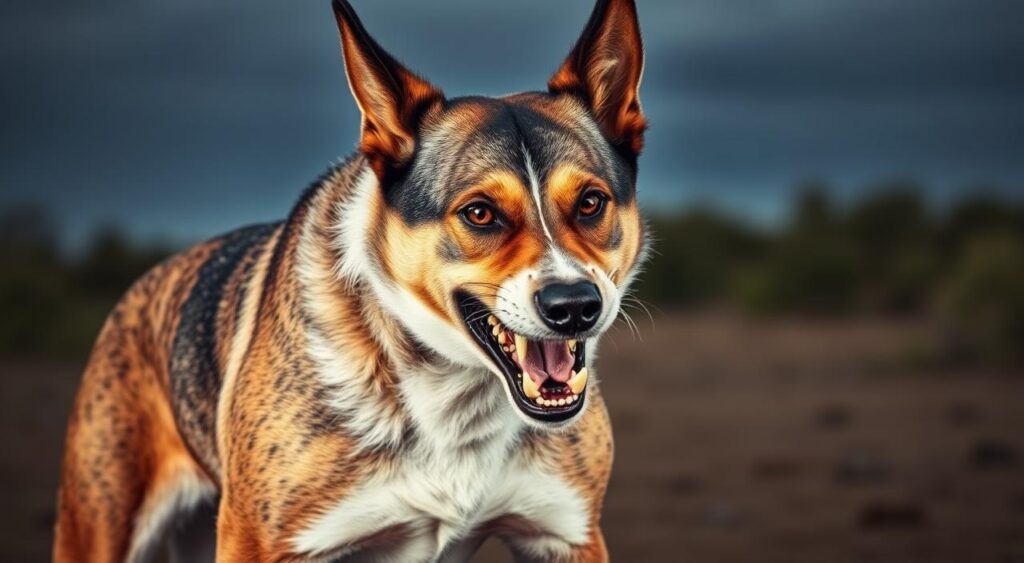
When correcting Australian cattle dog behavior, it’s important to understand different types of reactions. This can include fear reactions to loud sounds or new places. It can also include acting aggressively towards other dogs or threats in their area. Knowing what starts these behaviors helps in coming up with the right ways to deal with them.
To deal with Australian cattle dog aggression well, using the right tools is helpful. One useful tool is the Martingale collar. It’s known for being safe and stops dogs from getting loose in stressful times.
| Type of Reactivity | Description | Common Triggers |
|---|---|---|
| Fear-based | Reactivity due to fear or anxiety | Loud noises, unfamiliar people |
| Aggression-based | Protective or territorial reactions | Other dogs, unknown animals |
| Frustration-based | Reactivity when desires are blocked | Limited access to desired activities |
| Excitement-based | Overexcitement in stimulating situations | High-energy play, intense training sessions |
To reduce these behaviors, it helps to follow routines that meet the dog’s physical and mental needs. This means doing more than just short walks. Adding in lots of physical activities and brain games is a good idea.
Last, it’s a smart move to get help from a professional trainer or behaviorist for correcting Australian cattle dog behavior. This support helps both the pet and owner create a peaceful and rewarding life together. This includes picking the right activities and making behavior changes that really work.
Root Causes of Australian Cattle Dog Aggression
Understanding the root causes of aggression and separation anxiety in Australian cattle dogs is vital. These issues often come from the breed’s nature and their environment.
The Protective Instinct in Australian Cattle Dogs

Australian Cattle Dogs were bred for herding, making them territorial and protective. This trait can cause aggression if they see a threat to their family or home.
Observing Scout, a breed representative, highlights the effect of inherited traits and environment on this behavior. Scout, mostly cattle dog with some German Shepherd, shows how deep these protective instincts run.
Addressing Socialization and Anxiety in Aggressive Behavior
Socializing Australian cattle dogs is key to reducing aggression. The time between 3 to 14 weeks is crucial for this, helping them learn to handle new experiences calmly. Dogs like Scout, who missed early socialization, tend to be more reactive and aggressive. Pressuring them into scary situations can also lead to defensive aggression.
Training and positive experiences are important in tackling aggression and separation anxiety. They build the dog’s confidence and improve their coping skills. Properly understanding and addressing these issues helps in forming a better bond with Australian cattle dogs. It ensures a happier life for both the dogs and their owners.
Correcting Australian Cattle Dog Behavior with Obedience Training
Obedience training is key for Australian Cattle Dogs. These dogs are smart and lively but can be challenging. A regular training plan and precise commands help steer dogs towards good behavior. This makes Australian cattle dog obedience training essential for their owners.
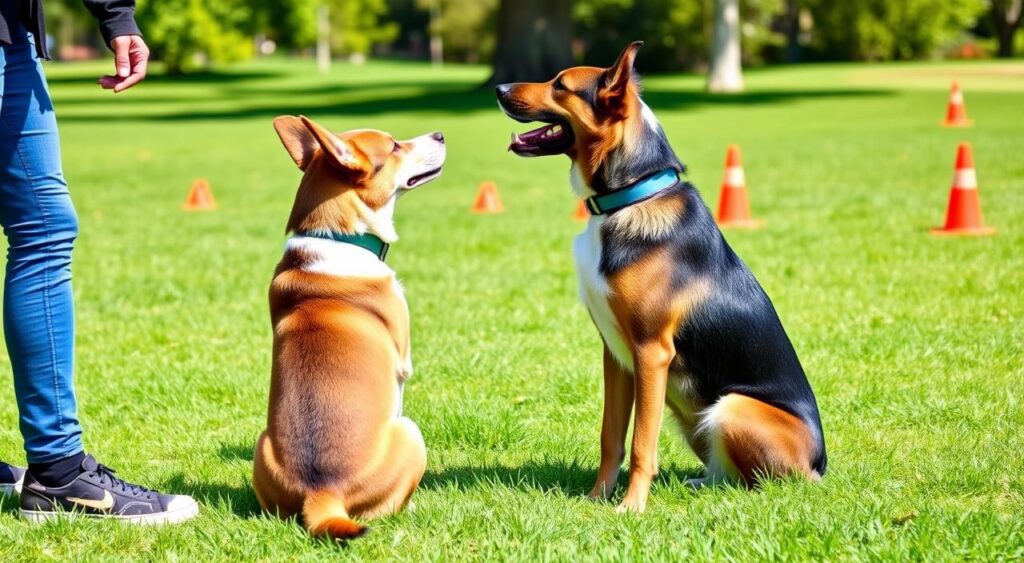
Importance of Consistent Training Routines
Consistency is crucial in training, especially for Australian cattle dog training tips. These dogs need structure. They need to know what’s expected of them. Training regularly and predictably helps set good habits. This assures your Australian Cattle Dog learns commands well and can follow them reliably. Training isn’t just now and then, but a dedicated routine focusing on the dog’s learning.
Effective Commands to Manage Behavioral Outbursts
Clear and consistent commands are necessary to fix bad behaviors. Commands like ‘sit’, ‘stay’, ‘come’, and ‘leave it’ help control sudden outbursts. Training should slowly introduce distractions. This teaches your dog to listen in different situations.
Correcting behaviors like too much barking or jumping starts with simple commands. Then, move to harder tasks as your dog gets better. Using the three Ds—Distance, Duration, and Distraction—makes training more effective. Slowly increase the time before rewards or train with distractions. This prepares your dog for real life. Avoid making your dog scared with corrections. Use redirection and positive rewards instead.
Good Australian cattle dog obedience training combines steady routines, clear commands, and training that gets harder over time. Owners should be patient and keep trying. If needed, seek professional help to tailor training for your dog’s specific needs.
Dealing with Australian Cattle Dog Separation Anxiety
Australian cattle dogs often feel anxious when left alone. This leads to behaviors like barking or chewing. Understanding their need for company and teaching them to be independent are key.
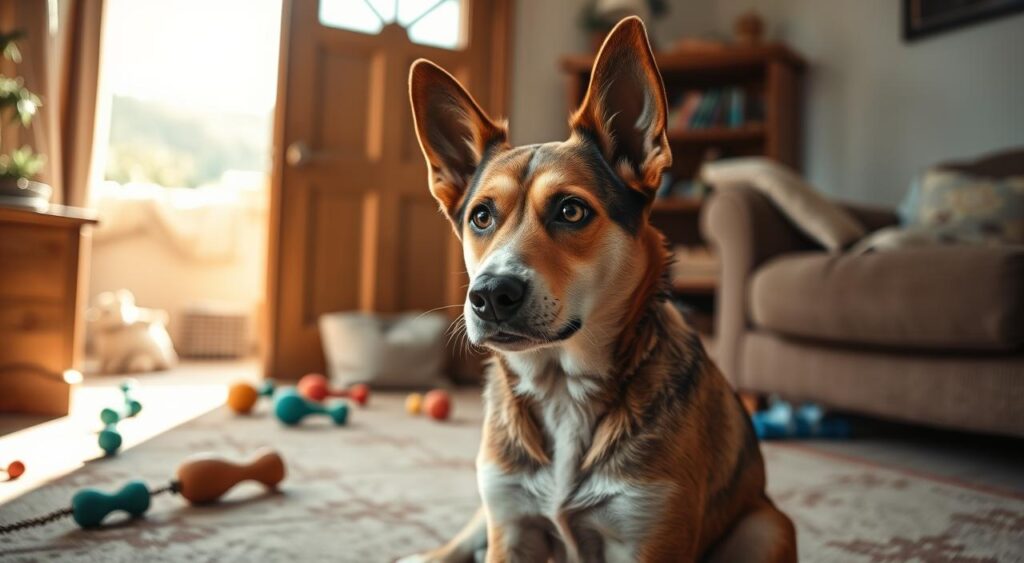
Keeping these dogs happy involves making their space interesting. This can be done with challenging toys and soothing sounds. Toys such as Kongs® or West Paw® puzzles keep their brains busy. Classical music or audio books help calm them, making them feel less alone.
Sometimes, medications are necessary to calm an anxious dog. Pills like diazepam or trazodone offer quick relief. But, it’s important to use them wisely, under a vet’s advice. This ensures the dogs do not develop a dependency or act aggressively.
- Encouraging independence through training like mat stays helps dogs feel secure even when you’re away.
- Regular physical and mental workouts are essential. They keep your dog healthy and reduce negative behaviors.
- For tough cases, professional advice from vets or behaviorists is key. They know how to manage anxiety best.
Some common methods for easing a dog’s separation anxiety:
| Strategy | Benefits | Considerations |
|---|---|---|
| Puzzle Toys | Reduces stress, mentally stimulating | Needs to match dog’s intellectual level |
| Pharmaceutical Aids | Quick relief from panic | Potential for dependency, professional consultation needed |
| Audio Stimulation | Soothes and distracts from noise triggers | Effectiveness varies by individual dog’s preferences |
| Independence Training | Builds confidence, reduces clingy behavior | Requires consistency and patience |
Dealing with a cattle dog’s anxiety requires patience and care. No single method works for all. But, combining different strategies often brings peace to both the dog and its owner.
Australian Cattle Dog Overexcitement: From Playful to Problematic
Australian cattle dog behavioral problems often come from their overexcitement. These dogs can quickly switch from playful to problematic without help. It’s crucial to understand and guide their behavior for everyone to live together happily.
Managing Overstimulation in Australian Cattle Dogs
Overstimulation in these dogs can lead to too much barking and jumping. Setting up structured routines can really help calm an excited dog. Tools like the Gentle Leader or Easy Walk Harness are big in managing excited dogs during walks. Adding in behavior changes through programs like Counter Conditioning can teach them to stay calm in exciting times.
Channeling Your Dog’s Energy into Productive Activities
Using a cattle dog’s energy in helpful ways can cut down on overexcitement problems. Activities that make them think and move are key. Things like structured play, agility training, or consistent games like fetch can be a big help. Meeting other dogs is also great for them. It helps them learn how to act and calm down around friends.
| Activity | Benefits |
|---|---|
| Structured Play | Reduces overexcitement, improves obedience |
| Agility Training | Engages mind and body, channels energy positively |
| Socialization | Teaches social cues, reduces aggressive tendencies |
To sum it up, it’s key to manage and use an Australian cattle dog’s energy wisely. Turning their energy into positive actions and steady training can turn a wild dog into a calm, focused friend. Tackling this with both exercise and mental and social activities is great for handling their behavior problems.
Australian Cattle Dog Herding Behavior: A Double-Edged Sword
The Australian cattle dog herding behavior is complex yet natural, making them leaders among working breeds. Their smarts and problem-solving shine in guiding animals with care. Yet, it’s vital for owners to correct this behavior if it goes off track.
Misdirected Herding Instincts and Their Consequences
Australian cattle dogs can become a challenge if their herding instinct isn’t managed. They might nip at kids or chase cars. This comes from their urge to herd moving things, which might include kids or pets at home. It’s critical to see these signs early and steer them right for everyone’s safety.
Training Tips for Herding Tendencies
To fix these behaviors, owners must train their dogs with consistency and positive vibes. They need fun and mind-engaging activities to avoid getting bored. Training that uses their herding drive in useful ways, like agility sports, works well.
| Focus Area | Strategy | Benefit |
|---|---|---|
| Intelligence | Cognitive games and puzzles | Keeps their mind active, preventing misbehavior due to boredom |
| Herding Instinct | Structured herding or agility training | Productive use of natural instincts |
| Social Behavior | Early socialization practices | Improves interactions with humans and other animals |
| Physical Exercise | Regular, vigorous exercise | Helps manage energy levels |
To sum up, success with Australian cattle dog herding behavior is about smartly guiding their instincts. With the right training, these dogs can enjoy a balanced life. Owners can help turn their pet’s natural herding behavior into a positive force.
Tackling Destructive Behaviors: Boredom and Lack of Exercise

To fix Australian cattle dog behavioral problems caused by boredom and lack of exercise, a good routine is needed. Doing exercises helps reduce bad behaviors like chewing. It’s key to their health too.
Australian cattle dog training tips suggest adding mental and physical tasks to their day. Try long walks, fetch, or agility courses. These suit their high energy and herding skills, making them happier.
- Exercise regularly: Schedule daily sessions of rigorous physical activities.
- Mental stimulation: Include puzzles and games that require mental engagement.
- Routine: Maintain a steady schedule of activities to prevent periods of boredom.
Adding these steps to your Australian cattle dog’s training helps reduce stress. It makes owning a dog more fun and peaceful.
| Dog Breed | Intelligence | Energy Level | Recommended Activities |
|---|---|---|---|
| Australian Cattle Dog | High | Very High | Herding simulations, obstacle courses |
| Border Collie | Very High | Very High | Agility competitions, off-leash play |
| Belgian Malinois | High | High | Protective training, police work simulations |
| German Shepherd | High | High | Guarding simulations, herding activities |
Adding the right exercises for Australian cattle dogs not only fixes Australian cattle dog behavioral problems. It also makes their life and their bond with you better.
Australian Cattle Dog Behavior Issues: Solutions through Enrichment
Addressing solutions for Australian cattle dog behavior means mixing mental and physical activities. These dogs are energetic and smart. They need regular chances for enrichment for Australian cattle dog. By combining brain games and physical workouts, their life quality improves. This also helps with their behavioral issues.
Intellectual Stimulation for an Active Mind
Australian Cattle Dogs are smart. They can learn up to 165 words or signals. They also have about 200 million smell sensors. Activities like scent work tire and please them. It uses their strong sense of smell to find treats or things. Puzzle feeders are great too. These feeders make them think before eating. This keeps their minds sharp and stops bad behaviors.
Physical Activities to Exhaust Excess Energy
Australian Cattle Dogs need a lot of exercise. They need one to two hours of hard play every day. They excel in agility trials and flyball. These sports meet their need to move and work. For busy days, a flirt pole exercise quickly tires them out. Regular exercise keeps them from acting out.
Combining mental and physical enrichment for Australian cattle dog solves solutions for Australian cattle dog behavior. It also strengthens the bond between dog and owner. This way, these lively dogs live happy, balanced lives. They keep their love for adventure too.
When to Seek Professional Help for Your Australian Cattle Dog
Figuring out when to get professional help for an Australian cattle dog is key. It helps you handle their unique behaviors effectively. Knowing when issues are too big for basic training is vital for any caring owner. This step isn’t just about better obedience, but also your pet’s happiness and mental health.
Recognizing When Behavioral Issues are Beyond Basic Training
Australian cattle dogs can face problems that basic training doesn’t fix. Issues like ongoing aggression, too much barking, or destroying things show this. Spotting these signs early is essential. Remember, these dogs need around two hours of exercise each day. Not getting it can cause these issues.
Early socialization and keeping their minds busy are crucial for these active dogs. Without it, they may get very anxious when alone or act out.
Benefits of Consulting a Behaviorist or Professional Trainer
Getting help from a pro for your dog’s troubles has many pluses. They offer training plans made just for Australian cattle dogs’ needs. These include their smarts and how energetic they are. Trainers use positive reinforcement, which is key for smart but stubborn dogs.
They also teach owners how to lead their dogs the right way. This prevents the dog from trying to be the boss. Besides fixing behavior now, professional help keeps your dog healthy and happy for the long term. This highlights the need for regular vet visits and a good diet.
In summary, while Australian cattle dogs are smart and can be trained, some behaviors may need a pro’s touch. Talking to experts not only fixes these problems but also makes life with your dog better. It improves your family’s life through pet ownership.
Conclusion
We’ve learned a lot about Australian Cattle Dogs (ACDs). They are smart and adaptable. They do well with the right care and training. It’s important to know that they aren’t naturally mean. With early training and socializing, they grow into happy companions.
Some think ACDs are aggressive. But, this is usually because of their upbringing, environment, or genetics. These dogs are great learners. They need structured training, plenty of exercises, and mental challenges. Regular vet visits are also key to their health.
In summary, Australian Cattle Dogs are both independent and loyal. With proper care, they become happy and obedient friends. For those who need extra help, there are resources. For example, information on goat farming subsidies can help. By understanding and meeting their needs, owners can have a strong bond with these dogs. This ensures these amazing dogs have a bright future.

